More Articles
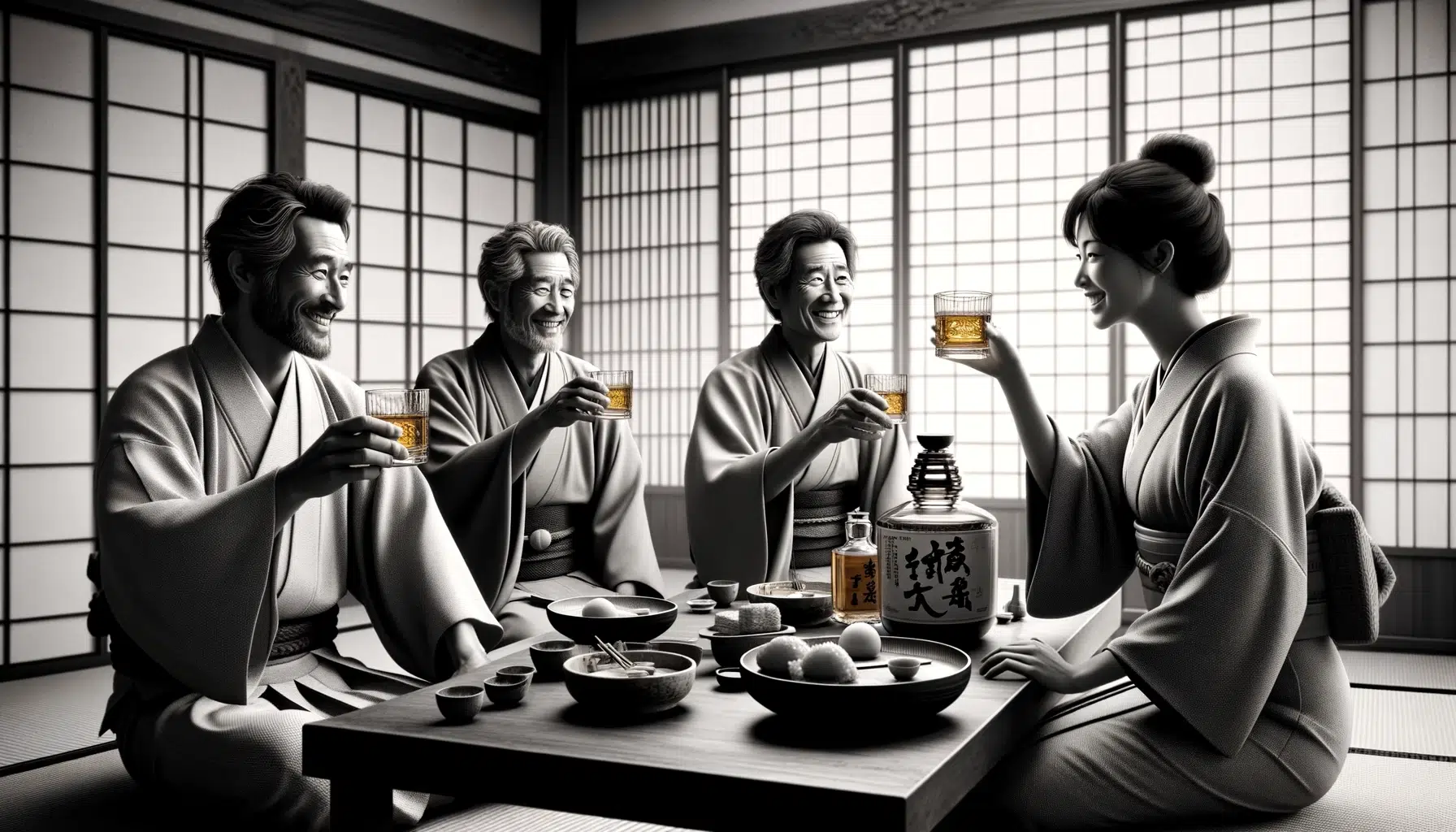
Best Japanese Whisky 2023
Japanese whisky has a unique flavor that is unlike any other whiskey in the world. It is often described as…
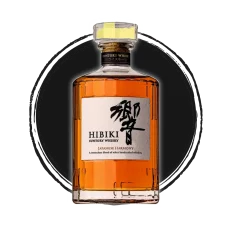
Hibiki Japanese Harmony
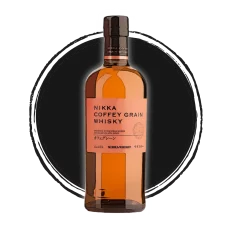
Nikka Coffey Grain Whisky
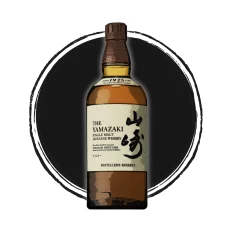
Suntory Yamazaki
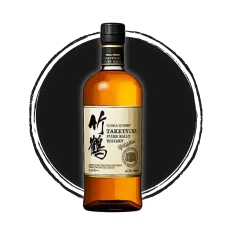
Nikka Taketsuru
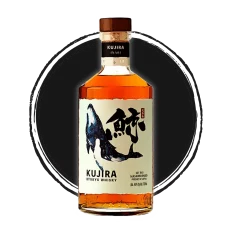
Kujira Ryukyu
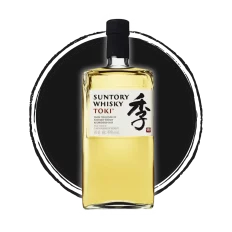
Suntory Toki
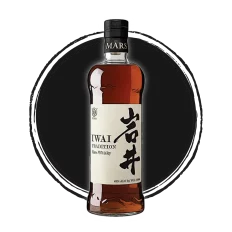
Mars Iwai Tradition
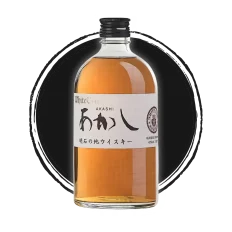
White Oak Akashi
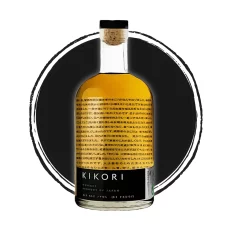
Kikori Japanese Whisky
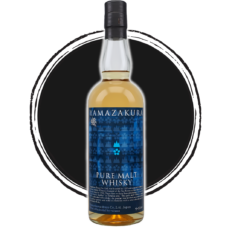
Yamazakura Pure Malt
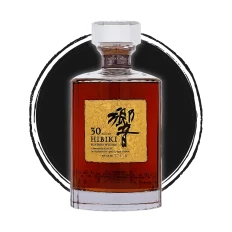
Suntory Hibiki 30
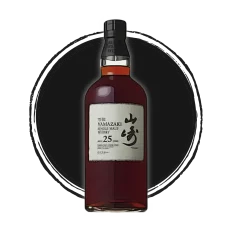
Single Malt Yamazaki 25
Japanese whisky has a unique flavor that is unlike any other whiskey in the world. It is often described as being light, smooth, and delicate. The flavor is the result of a combination of factors, including the type of grain that is used to make the whiskey, the water that is used in the distillation process, and the aging process. Most Japanese whiskeys are aged for years in oak barrels, which gives them their own unique flavor.
What Is Japanese Whisky?
Japanese whisky is a type of whisky that is made in Japan. It is made from a blend of corn, rye, and barley malt and typically has a smoky flavor. Some of the most popular brands of Japanese whisky include Suntory, Nikka, and Hibiki. In recent years, Japanese whisky has become increasingly popular in the United States and other parts of the world.
What Is The Most Popular Whisky In Japan?
Suntory is the most popular whisky producer in Japan, and Yamazaki is their most popular whisky. Suntory began producing Yamazaki in 1923, and it quickly became a bestseller. Today, Yamazaki is the world’s most-awarded single-malt whisky. It has a rich flavor that’s been described as “luxurious, multi-layered, and mellow.”
Which Japanese Whisky Should I Try?
There are a few Japanese whiskies that you should try. Beginners should try the Nikka Coffey Grain Whisky. It has a sweet and fruity flavor with hints of vanilla and oak.
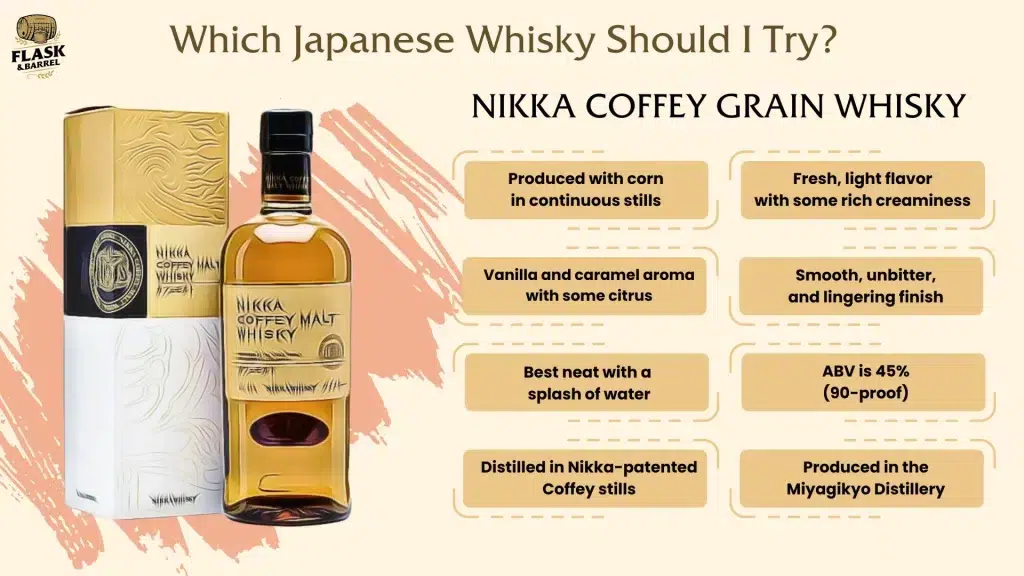
Another great option is the Yamazaki 12-Year-Old Single Malt Whisky. It has a smoky flavor with notes of toffee, honey, and citrus. If you’re looking for something more complex, the Suntory Hakushu 25-Year-Old Single Malt Whisky is a good option. It has a rich and woody flavor with hints of smoke, herbs, and fruit.
Why Is Japanese Whisky So Good?
Japanese whisky is so good because the distillers use quality ingredients and take their time to produce a high-quality product. The malt is barley that has been roasted until it’s black, and the water used in the whisky comes from the natural springs that are found on the property. The distilleries use traditional methods and a slow distillation process to make their whisky, and they don’t rush to get the product onto the market. They want to make sure that they’re producing a high-quality whisky that will please their customers.
What Is The Best Japanese Whisky?
Suntory Yamazaki 12 Year is the best Japanese whisky. It has a complex flavor with hints of vanilla, honey, and fruit. It’s a well-rounded whisky that can be enjoyed neat or on the rocks.
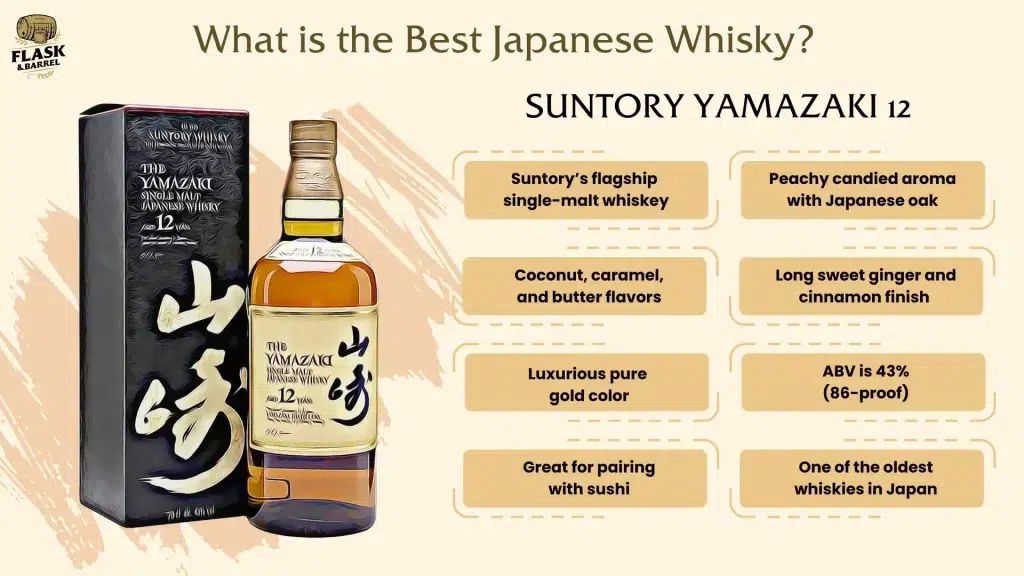
It’s also been voted the best whisky in the world by several spirits rating organizations.
What Is The Best 12-Year-Old Japanese Whisky?
The best 12-year-old Japanese whisky is the Suntory Yamazaki Single Malt Whisky. This whisky has a complex flavor with layers of malt, fruit, and oak that are well-balanced and deliver a smooth, mellow taste. It is aged for 12 years in American, Spanish, and Portuguese oak casks, which gives it its unique flavor. Plus, it has been awarded many accolades, including “Best Japanese Whisky” at the World Whiskies Awards in 2013 and 2016.
What are the Most Popular Japanese Whisky Brands
The landscape of Japanese whisky is dominated by several key players, each contributing to the global prestige and popularity of this exquisite spirit. Suntory and Nikka Whisky stand at the forefront, renowned for their exceptional quality, innovative distillation techniques, and deep-rooted heritage. Asahi, Shinshu Mars, and Kirin Company also play significant roles, offering unique expressions that cater to diverse palates.
Smaller yet impactful, Hombo Shuzo and Venture Whisky highlight the artisanal aspect of Japanese whisky making, focusing on craftsmanship and small-batch productions. Together, these brands encapsulate the essence of Japanese whisky, from the rich, complex flavors to the meticulous attention to detail, making them highly sought after by connoisseurs and novices alike.

Suntory
Suntory stands as a pillar of excellence in the Japanese whisky world, known for its pioneering spirit and exceptional offerings. Its flagship expressions, such as Yamazaki, Hakushu, and the blended Hibiki, have earned global recognition for their balance, complexity, and sheer elegance.
Nikka Whisky
A testament to innovation and tradition, Nikka Whisky is revered for its rich character and diverse flavor profiles. Its distilleries, Yoichi and Miyagikyo, produce whiskies that range from smoky to fruity and floral, showcasing the depth of Japanese whisky craftsmanship.
Asahi
Primarily celebrated for its beer, Asahi has ventured into the whisky realm with notable success, particularly through its acquisition of the Ben Nevis distillery in Scotland. This strategic move has enabled Asahi to fuse Scottish and Japanese whisky-making traditions, offering unique and flavorful expressions.
Shinshu Mars
Located in the heart of the Japanese Alps, Shinshu Mars distillery benefits from a high-altitude environment, producing whiskies that are smooth, delicate, and nuanced. The cooler climate and pristine water source are key contributors to its distinctive whisky profile.
Kirin Company
Beyond its status as a beverage giant, Kirin Company also produces distinguished Japanese whiskies. Its Fuji Gotemba distillery, positioned at the foothills of Mount Fuji, uses the exceptional natural surroundings to craft whiskies noted for their clarity and subtlety.
Hombo Shuzo
Hombo Shuzo, the powerhouse behind Shinshu Mars, also operates the Tsunuki distillery, showcasing its dedication to whisky making. It blends traditional techniques with modern innovation to create whiskies that mirror the rich diversity of Japan’s landscapes.
Venture Whisky
The driving force behind the acclaimed Chichibu distillery, Venture Whisky represents the new wave of Japanese whisky. Specializing in small-batch, artisanal production, Chichibu’s whiskies are sought after for their exceptional craftsmanship and distinctive flavors, marking Venture Whisky as a notable player in the industry.
Best Japanese Whisky Under $100
Discovering exceptional Japanese whisky doesn’t require an extravagant budget. Within the under $100 price range, enthusiasts can explore a variety of high-quality, accessible options that exemplify the craftsmanship and unique flavor profiles Japan is known for. Nikka Coffey Grain offers a sweet, vibrant taste, while Taketsuru blends malt whiskies for a harmonious flavor.
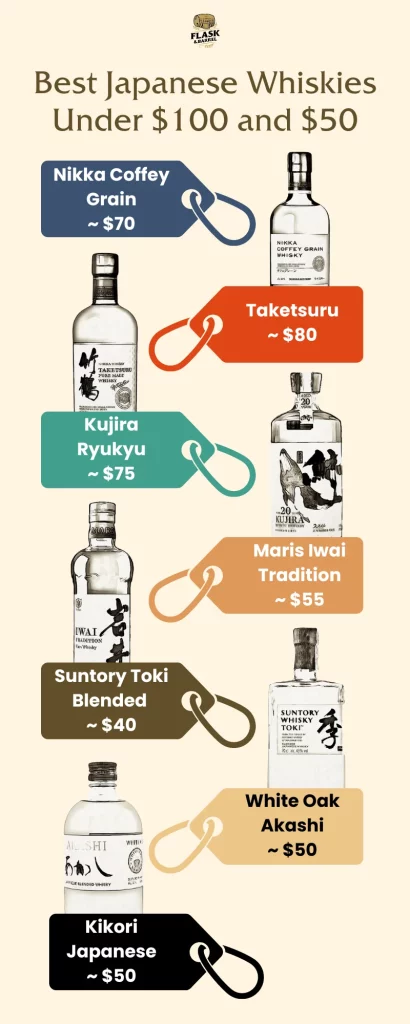
Kujira Ryukyu Whisky is a lesser-known but fantastic option for Japanese whisky newbies, while Maris Iwai Tradition is a great blended option. Each of these selections provides a gateway to the refined world of Japanese whisky, making them ideal for both newcomers and seasoned drinkers looking to expand their collections without breaking the bank.
Nikka Coffey Grain
Nikka Coffey Grain stands out with its innovative use of Coffey stills for grain whisky production, delivering a profile rich in sweetness and complexity. Enthusiasts will appreciate its vibrant notes of tropical fruits, vanilla, and a subtle hint of caramel, making it a delightful exploration of Japanese whisky’s versatility within an accessible price range.
Taketsuru
Named in honor of Masataka Taketsuru, the father of Japanese whisky, Taketsuru is a harmonious blend of malt whiskies from Nikka’s Yoichi and Miyagikyo distilleries. This blend masterfully combines peaty smokiness with fruity sweetness, offering a complex and layered taste that pays homage to Taketsuru’s legacy and craftsmanship.
Kujira Ryukyu Whisky
Kujira Ryukyu Whisky is a medium-bodied Japanese whisky produced with Japanese rice grains. It features sweet caramel aromas and delicious light fruit flavors, making for an excellent entry-level whisky.
Maris Iwai Tradition
If you’re looking for a delectable blended Japanese whisky under $100, the Maris Iwai Tradition is for you. This peaty, malty, and smoky whisky has a peppercorn and nutty flavor that pairs well with red meats. It’s aged in bourbon, sherry, and wine casks.
Best Japanese Whisky Under $50
Exploring the world of Japanese whisky does not have to strain your wallet, as the under $50 category proves. This price bracket is perfect for those curious about stepping into the realm of these distinguished spirits without committing to higher-end price tags. Options like Eigashima Akashi Limited Edition, Yamazakura Pure Malt, and Togouchi – Japanese Blended Whisky offer a taste of the craftsmanship and flavor diversity characteristic of Japanese whisky.
Each selection provides an accessible entry point, showcasing the subtleties and nuances that make Japanese whisky uniquely appealing. Whether you’re a newcomer or a seasoned enthusiast looking for everyday sips, this category holds promising discoveries that defy their modest pricing.
Suntory Toki Blended Whisky
Suntory Toki Blended Whisky was a 2017 International Spirits Competition Gold Medal winner and is among the most well-known Japanese whisky variants. It features familiar vanilla notes with grapefruit and nut nuances.
White Oak Akashi Whisky
Are you on the market for something that isn’t too intense? Try the White Oak Akashi Whisky! This whisky was the first Japanese distilled whisky launched in 1919. It features initial bourbon flavors, leading into sweet and savory notes and a peaty finish that isn’t too intense.
Kikori Japanese Whisky
Kikori Japanese Whisky is distilled from rice and mountain water, resulting in high floral notes with some fruit and vanilla flavors. Its aroma features shochu, a Native Japanese distilled beverage. This blended whisky is aged in American and French oak barrels or sherry casks.
Best Japanese Whiskies to Collect
For collectors and connoisseurs alike, Japanese whiskies present a realm of exquisite and often rare bottles that are as much a pleasure to display as they are to sip. Among the most coveted are Suntory’s Hibiki 30, a masterpiece of blending artistry; Single Malt Yamazaki 25, known for its exceptional depth and complexity; Yamazaki 12, a pioneer that has set the standard for single malts in Japan; and Hakushu 12, celebrated for its fresh, green, and smoky notes. These whiskies not only represent the pinnacle of Japanese distilling skills but also serve as valuable investments, with their value appreciating over time.
Whether for the joy of tasting or the thrill of the hunt, these bottles are essential additions to any serious whisky collection.
Suntory’s Hibiki 30
Suntory’s Hibiki 30 stands as a testament to the art of whisky blending, combining multiple malt and grain whiskies aged for at least 30 years. This blend achieves a remarkable depth and complexity, with a symphony of flavors that embody elegance and sophistication. Its scarcity and exceptional tasting profile have made it a coveted jewel for collectors around the globe.
Single Malt Yamazaki 25
Single Malt Yamazaki 25 is the epitome of Suntory’s distilling mastery, matured for twenty-five years to achieve an extraordinary depth of flavor. It unfolds layers of rich fruit, profound oakiness, and a velvety finish, making it a prestigious and sought-after bottle for any serious collector.
Yamazaki 12
Yamazaki 12 has set a benchmark for Japanese single malts, offering a harmonious blend of fruit, spice, and wood. Its nuanced complexity and recognition as a pioneer in the category have earned it a place of honor among collectors, symbolizing the essence of Japanese whisky craftsmanship.
Hakushu 12
Hakushu 12 is distinguished by its fresh, green profile with a hint of smoke, mirroring the pristine nature of its highland distillery. This whisky showcases the versatility of Japanese whisky, blending the crispness of green notes with the depth of smokiness, a combination that is highly prized by collectors for its uniqueness and complexity.
Best Japanese Whisky for Beginners
Entering the world of Japanese whisky can be an enriching experience, especially for beginners looking to explore this revered category. Selecting the right bottle is key to appreciating the subtleties and depth that Japanese whisky has to offer. For those new to the scene, whiskies that are smooth, approachable, and rich in flavor, yet not overwhelming, make the ideal starting point.
Options such as the Yamazaki 12, known for its harmonious blend of fruit and spice, or the Hakushu 12, with its fresh and slightly smoky notes, offer a gentle introduction. Similarly, Nikka Coffey Grain, with its sweet and vibrant profile, and Hibiki Harmony, celebrated for its floral and honey nuances, are excellent choices for those beginning their journey into Japanese whisky. These selections not only provide an accessible entry into the complex world of whisky but also lay the foundation for a deeper appreciation of the craftsmanship behind each bottle.
To further assist beginners in making an informed choice, here are some specifics organized in a detailed markdown table:
| Whisky Name | Flavor Profile | Availability | Reason to Try |
|---|---|---|---|
| Yamazaki 12 | Peach, pineapple, grapefruit, clove, candied orange, vanilla, Mizunara (oak). | Specialty liquor stores, online. | A rich blend offering a perfect first step into Japanese single malts. |
| Hakushu 12 | Fresh, herbal, with a hint of peppermint and melon, slightly smoky. | Well-stocked liquor shops, online. | Ideal for those enjoying a hint of smokiness, showcasing the fresh and green side of whisky. |
| Nikka Coffey Grain | Sweet, fruity, creamy, with tropical fruits, vanilla, and a hint of caramel. | Larger liquor stores, online. | Demonstrates the versatility of whisky made in a Coffey still, offering a sweet and vibrant taste. |
| Hibiki Harmony | Floral, honey, with a subtle woody finish. | High-end liquor stores, online. | A symphony of malt and grain whiskies, aged in various casks, ideal for exploring blended whisky. |
What is the Best Peaty Japanese Whiskey
When it comes to peaty Japanese whisky, aficionados seek bottles that deliver the distinctive smoky characteristic synonymous with peat, while still embodying the elegance and precision of Japanese distilling. The Yoichi Single Malt stands out in this category, offering a profound peaty profile that doesn’t overpower its complex layers of fruit and spice. Crafted at Nikka’s Yoichi distillery, located in Hokkaido, this whisky reflects the traditional Scottish influence on Japanese whisky-making, with its coastal location contributing to its unique flavor profile.
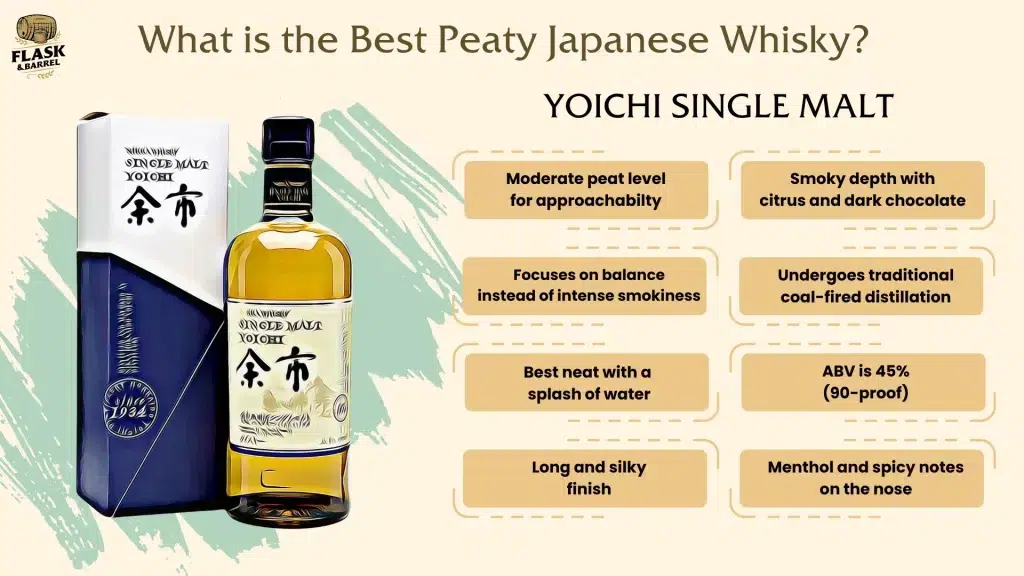
For those in pursuit of a peaty Japanese whisky that balances intensity with the nuanced craftsmanship Japan is renowned for, Yoichi Single Malt is a quintessential choice. The peatiness of Yoichi Single Malt is distinctively balanced, offering a smoky depth that is complemented by a rich array of flavors including citrus, chocolate, and a hint of sea salt, making it stand out from both its Japanese counterparts and peaty whiskies from regions like Islay. Its peat level is moderate compared to the heavily peated whiskies of Scotland, making it an excellent entry point for those new to peaty spirits as well as a refined choice for seasoned peat enthusiasts looking for a whisky with elegance and complexity.
The Yoichi distillery’s traditional coal-fired distillation process adds to the whisky’s character, imparting a unique smokiness that is hard to find in other Japanese whiskies. This method, combined with the distillery’s coastal location, infuses Yoichi Single Malt with its signature peaty profile while maintaining the smoothness and precision that Japanese whiskies are known for. Whether enjoyed neat, with a splash of water, or as part of a sophisticated cocktail, Yoichi Single Malt offers a peaty experience that is both accessible and deeply satisfying, making it a standout choice for those seeking the best in peaty Japanese whisky.
To provide a clearer understanding for readers seeking peaty profiles, here are additional specifics about Yoichi Single Malt:
- Peat Level: Moderate, offering a balanced peatiness that is approachable for newcomers to peaty whisky while still satisfying for peat aficionados.
- Tasting Notes: A complex blend of smoky depth with layers of citrus, dark chocolate, and a subtle coastal influence, leading to a rich and satisfying finish.
- Comparison to Other Peaty Whiskies: While Scottish peated whiskies often emphasize the intense smokiness, Yoichi Single Malt focuses on balance, integrating its peat smoke with the whisky’s inherent flavors to create a harmonious and complex profile. This makes Yoichi distinctly different from both its Japanese counterparts, which may offer lighter peat profiles, and the heavily peated whiskies from regions like Islay in Scotland.
- Enjoyment Tips: Best enjoyed neat or with a splash of water to open up its complex flavors. For those new to peaty whisky, Yoichi Single Malt serves as an excellent introduction to the category, offering a glimpse into the elegance and depth that peated Japanese whisky can offer.
Yoichi Single Malt’s unique balance of peat, complexity, and elegance makes it an exemplary choice for those exploring the peaty side of Japanese whisky, offering a distinct experience that bridges the gap between Japanese precision and the bold character of peat.
Single Malt Japanese Whiskies
Single malt Japanese whiskies represent the pinnacle of the country’s whisky production, showcasing the depth and diversity of flavors achievable through the careful selection of malted barley, water, and aging processes. These whiskies are celebrated for their purity, complexity, and the meticulous attention to detail maintained by Japanese distillers. Notable expressions such as Yamazaki, Hakushu, and Miyagikyo highlight the range of profiles available, from the rich and fruity to the delicately smoky and peated.
Each distillery brings its unique approach to the craft, influenced by its environment and heritage, resulting in whiskies that are not just beverages but a form of art. For enthusiasts looking to explore the essence of Japanese whisky, single malts offer a rich tapestry of tastes and aromas that are both inviting and rewarding.
Is Japanese Whisky Made in Japan?
Yes, authentic Japanese whisky is indeed distilled and aged within the borders of Japan, adhering to a tradition and craftsmanship deeply embedded in the country’s culture. This ensures the spirit is imbued with the unique environmental and cultural qualities of Japan. From the selection of local ingredients to the employment of specific distillation techniques, every step underscores the Japanese dedication to quality and precision in whisky making.
What are the Best Japanese Whisky Glasses?
The best Japanese whisky glasses are crafted to elevate the tasting experience, emphasizing the whisky’s aroma and flavor. Glencairn glasses and Tulip glasses stand out for their shape, which expertly concentrates the whisky’s aromatics for a fuller appreciation of its complexity.
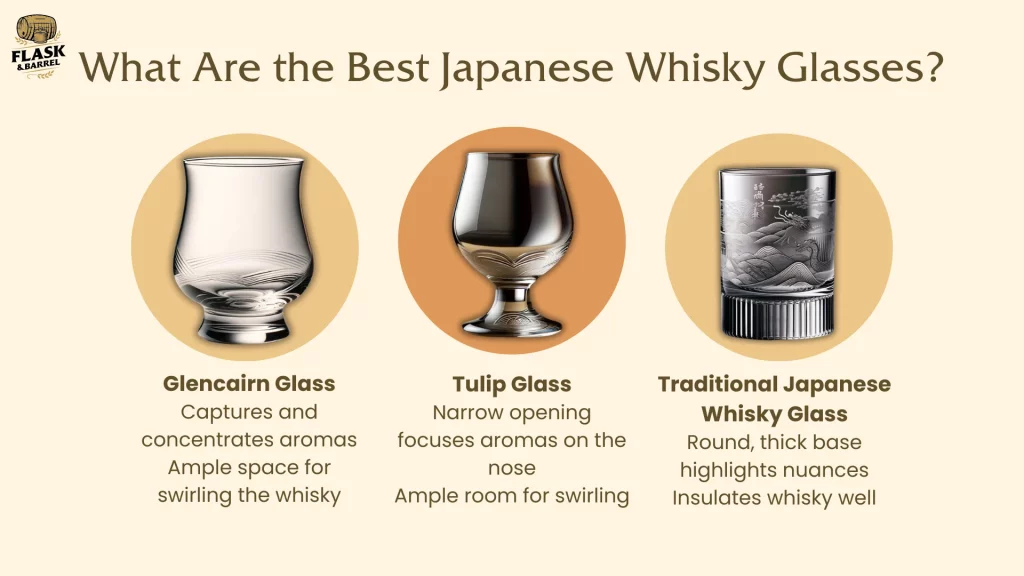
Moreover, traditional Japanese whisky glasses, characterized by a wider base and a gentle taper, merge aesthetic elegance with functional design.
Does All Japanese Whisky Taste Like Scotch?
No, not all Japanese whiskies taste like Scotch. In fact, there are many different types of whisky made in Japan, and they each have their own unique flavor profile. Some are similar to Scotch, while others are quite different. That being said, most Japanese whiskies are made using barley malt, and this gives them a certain flavor profile that is often compared to Scotch whiskies. If you’re not a fan of Scotch whisky, then you may not enjoy Japanese whiskies as much either. But if you do enjoy Scotch whiskey, you’ll likely enjoy most Japanese whiskies as well.
What Is Japanese Whisky Made Out Of?
Japanese whisky is made from a variety of grains, including barley, corn, and rice. The whiskies are usually distilled twice, and they are often aged in oak barrels. In the past few years, Japanese whisky has become more and more popular, and it has won a number of awards at international spirits competitions. Some people prefer Japanese whisky to Scotch whisky because it has a smoother flavor.
What Is A Good Japanese Whisky Gift?
There are a few different types of Japanese whisky to choose from, so it really depends on what the giftee likes. If they prefer a smoky flavor, then something like the 12-year-old Yamazaki would be a good choice. For those who prefer a sweeter whisky, the Hibiki 17-year-old is a good option. No matter which whisky you choose, make sure to get a bottle that is sealed with Japanese whisky tax stamps. This means that the whisky was made in Japan and meets the high quality standards of that country.
Can Japanese Whisky Be Called Bourbon?
No. In order for a whisky to be called Bourbon, it must meet certain requirements as specified by the United States government. These requirements include that the whisky be made in the United States and that it be made from a grain mixture that is at least 51% corn. Japanese whiskies do not meet these requirements, so they cannot legally be called Bourbons. However, this does not mean that they aren’t good whiskies! In fact, many people consider Japanese whiskies to be some of the best in the world. So if you’re looking for a good whisky and you don’t mind something that’s not technically Bourbon, then I highly recommend giving Japanese whiskies a try.
What Grain Is Used In Japanese Whisky?
Japanese whisky is made with rice. The type of rice used is called “sake koji,” which is a type of short-grain, sweet, sticky rice that’s been inoculated with the Aspergillus oryzae mold. The mold converts the starch in the rice into malt sugar, which is then fermented to make whisky.
